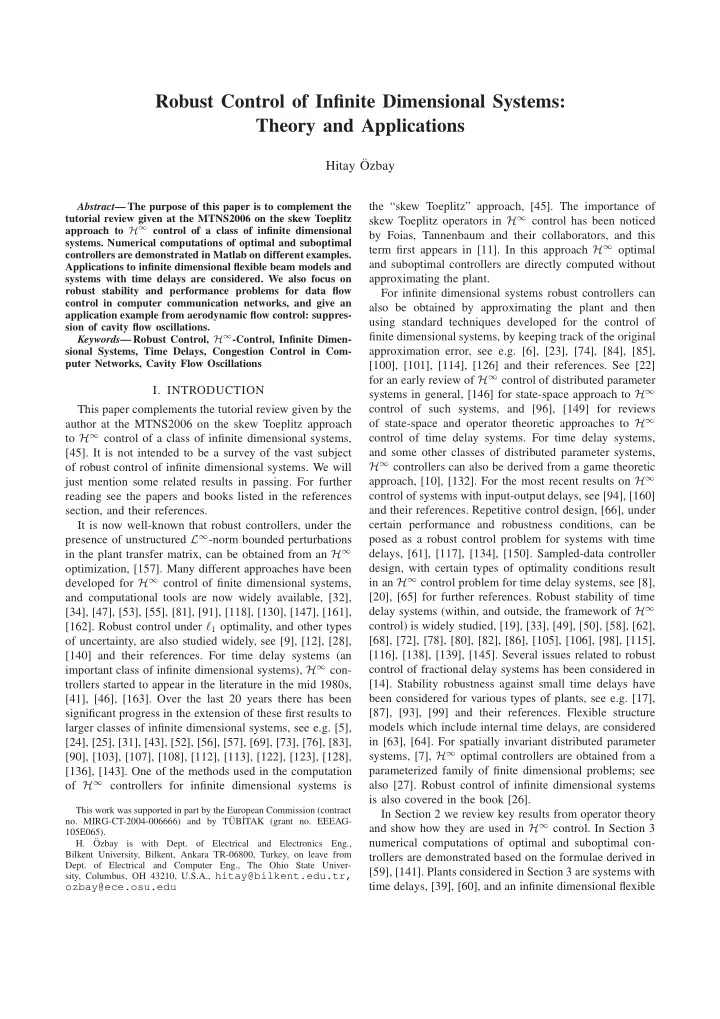

Robust Control of Infinite Dimensional Systems: Theory and Applications Hitay ¨ Ozbay Abstract — The purpose of this paper is to complement the the “skew Toeplitz” approach, [45]. The importance of skew Toeplitz operators in H ∞ control has been noticed tutorial review given at the MTNS2006 on the skew Toeplitz approach to H ∞ control of a class of infinite dimensional by Foias, Tannenbaum and their collaborators, and this systems. Numerical computations of optimal and suboptimal term first appears in [11]. In this approach H ∞ optimal controllers are demonstrated in Matlab on different examples. and suboptimal controllers are directly computed without Applications to infinite dimensional flexible beam models and approximating the plant. systems with time delays are considered. We also focus on robust stability and performance problems for data flow For infinite dimensional systems robust controllers can control in computer communication networks, and give an also be obtained by approximating the plant and then application example from aerodynamic flow control: suppres- using standard techniques developed for the control of sion of cavity flow oscillations. Keywords — Robust Control, H ∞ -Control, Infinite Dimen- finite dimensional systems, by keeping track of the original sional Systems, Time Delays, Congestion Control in Com- approximation error, see e.g. [6], [23], [74], [84], [85], puter Networks, Cavity Flow Oscillations [100], [101], [114], [126] and their references. See [22] for an early review of H ∞ control of distributed parameter I. INTRODUCTION systems in general, [146] for state-space approach to H ∞ This paper complements the tutorial review given by the control of such systems, and [96], [149] for reviews of state-space and operator theoretic approaches to H ∞ author at the MTNS2006 on the skew Toeplitz approach to H ∞ control of a class of infinite dimensional systems, control of time delay systems. For time delay systems, and some other classes of distributed parameter systems, [45]. It is not intended to be a survey of the vast subject H ∞ controllers can also be derived from a game theoretic of robust control of infinite dimensional systems. We will approach, [10], [132]. For the most recent results on H ∞ just mention some related results in passing. For further control of systems with input-output delays, see [94], [160] reading see the papers and books listed in the references and their references. Repetitive control design, [66], under section, and their references. certain performance and robustness conditions, can be It is now well-known that robust controllers, under the presence of unstructured L ∞ -norm bounded perturbations posed as a robust control problem for systems with time in the plant transfer matrix, can be obtained from an H ∞ delays, [61], [117], [134], [150]. Sampled-data controller design, with certain types of optimality conditions result optimization, [157]. Many different approaches have been in an H ∞ control problem for time delay systems, see [8], developed for H ∞ control of finite dimensional systems, [20], [65] for further references. Robust stability of time and computational tools are now widely available, [32], delay systems (within, and outside, the framework of H ∞ [34], [47], [53], [55], [81], [91], [118], [130], [147], [161], [162]. Robust control under ℓ 1 optimality, and other types control) is widely studied, [19], [33], [49], [50], [58], [62], of uncertainty, are also studied widely, see [9], [12], [28], [68], [72], [78], [80], [82], [86], [105], [106], [98], [115], [140] and their references. For time delay systems (an [116], [138], [139], [145]. Several issues related to robust important class of infinite dimensional systems), H ∞ con- control of fractional delay systems has been considered in trollers started to appear in the literature in the mid 1980s, [14]. Stability robustness against small time delays have [41], [46], [163]. Over the last 20 years there has been been considered for various types of plants, see e.g. [17], significant progress in the extension of these first results to [87], [93], [99] and their references. Flexible structure larger classes of infinite dimensional systems, see e.g. [5], models which include internal time delays, are considered in [63], [64]. For spatially invariant distributed parameter [24], [25], [31], [43], [52], [56], [57], [69], [73], [76], [83], systems, [7], H ∞ optimal controllers are obtained from a [90], [103], [107], [108], [112], [113], [122], [123], [128], parameterized family of finite dimensional problems; see [136], [143]. One of the methods used in the computation of H ∞ controllers for infinite dimensional systems is also [27]. Robust control of infinite dimensional systems is also covered in the book [26]. This work was supported in part by the European Commission (contract In Section 2 we review key results from operator theory no. MIRG-CT-2004-006666) and by T ¨ UB˙ ITAK (grant no. EEEAG- and show how they are used in H ∞ control. In Section 3 105E065). ¨ numerical computations of optimal and suboptimal con- H. Ozbay is with Dept. of Electrical and Electronics Eng., Bilkent University, Bilkent, Ankara TR-06800, Turkey, on leave from trollers are demonstrated based on the formulae derived in Dept. of Electrical and Computer Eng., The Ohio State Univer- [59], [141]. Plants considered in Section 3 are systems with sity, Columbus, OH 43210, U.S.A., hitay@bilkent.edu.tr, ozbay@ece.osu.edu time delays, [39], [60], and an infinite dimensional flexible
Recommend
More recommend